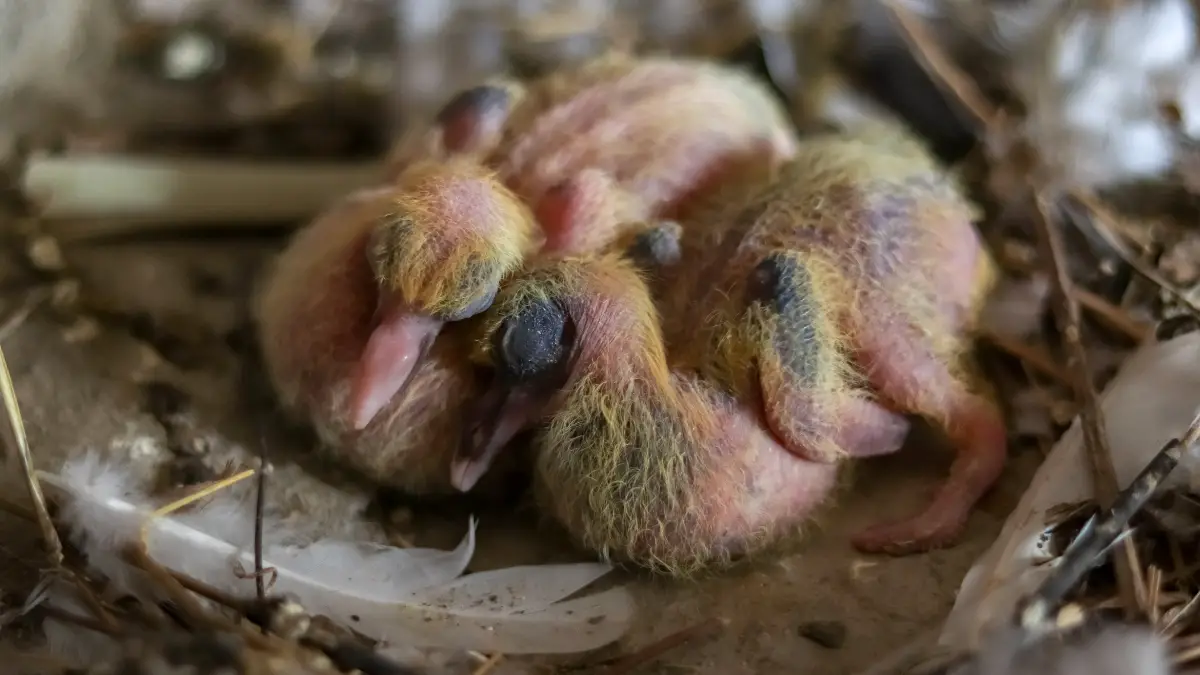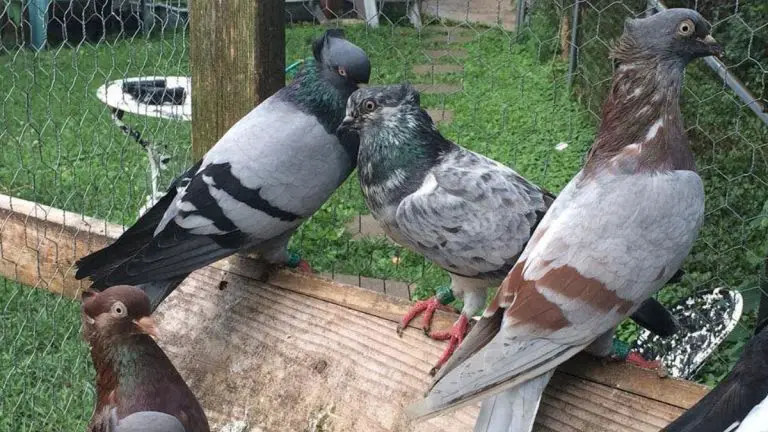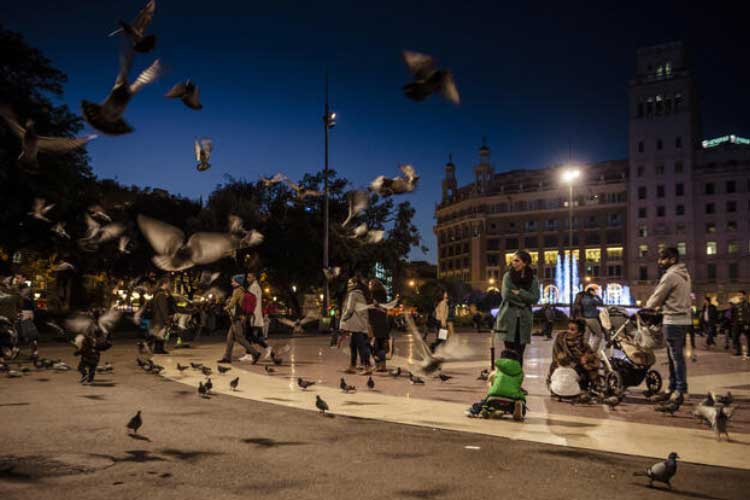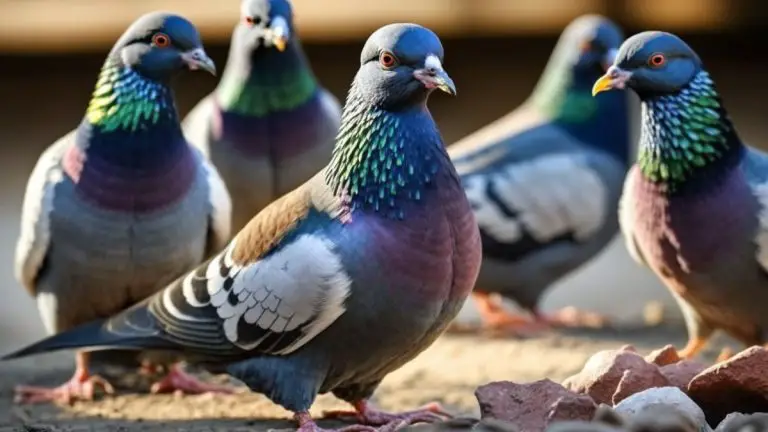The Development of Pigeon Chicks: A Comprehensive Guide
As pigeon chicks grow from an embryo to a fully-fledged bird, they undergo physical and behavioral changes. These changes are collectively referred to as the “development process.” It encompasses various stages, including embryonic, neonatal, and postnatal. Each stage is marked by distinct milestones and challenges
This knowledge of the development of pigeon chicks is essential not only for bird enthusiasts, but also for anyone involved in the care and management of captive pigeon populations. It includes researcher, breeders and zookeepers.
In this article, we will provide a comprehensive guide to the development stages of pigeon chicks. Here we cover the various stages of pigeon growth and the physical & behavioral changes.
All these occur during each stage, including incubation, hatching, and fledging. Here we’ll also describe the procedure of incubating and chick hatching.
The Egg Incubation Process And Its Importance
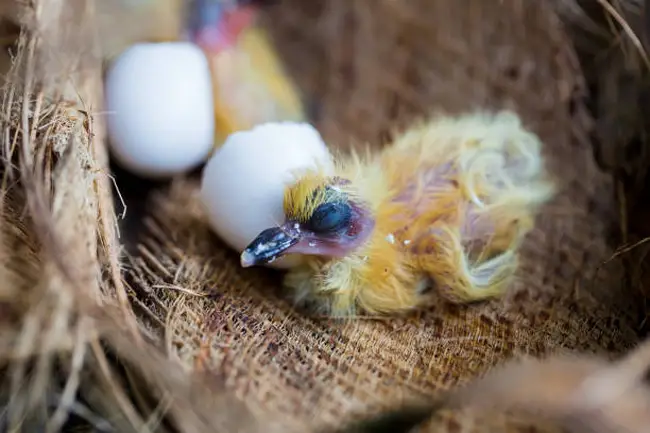
Egg incubation is a crucial process for the development of pigeon chicks. Pigeons’ gestation periods can range from 10 to 14 days. Here are the steps.
- Pigeon lays an egg, which is incubated in a nest.
- During incubation, parent pigeons maintain a constant temperature of around 37.5°C (99.5°F).
- A primitive streak appears on the first day of incubation, allowing the formation of three layers of cells.
- Over the next few days, the chick’s organs and structures develop from these three layers.
- Egg weight loss is due to water loss. And that is an indicator of proper or poor embryonic development.
- Chick prepares to hatch by using its egg tooth to break open the shell.
- After hatching, the chick continues to develop and grow under the care of its parent pigeons.
Pigeon chicks must successfully hatch and develop during the egg incubation process. Otherwise, the embryos may not develop properly or die.
Pigeon Egg Incubation Period and Development Factors
The natural incubation period for eggs is typically 18 days. Pigeon eggs do not require preservation. And it can be incubated immediately after being collected and sterilized on the same day.
During incubation, humidity levels need to be carefully monitored and ensure optimal conditions for proper egg development. This process is usually closely monitored by the parents.
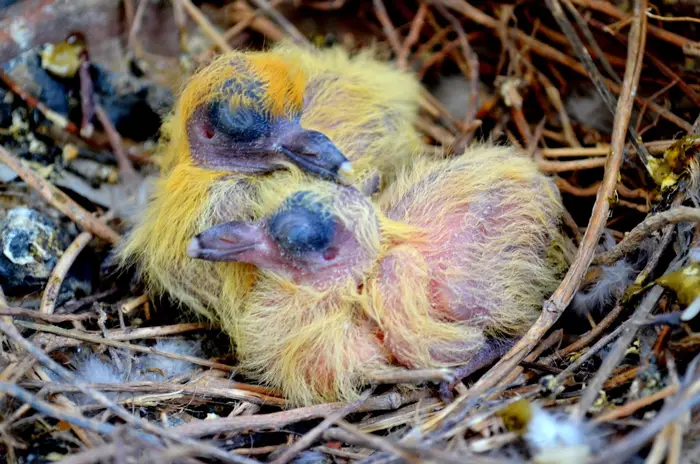
However, several facts affect the incubation of pigeon eggs. Factors that can affect egg development are as follows.
- Temperature fluctuations: Variations in temperature from the ideal range of 98-100°F can impact embryo development and hatchability.
- Humidity levels: Proper humidity levels of 50-55% during incubation are crucial for maintaining egg moisture and facilitating hatching.
- Egg fertility: The percentage of fertile eggs in a pigeon batch can vary based on numerous factors. It includes age of the breeding stock and mating conditions, but is typically around 85-90%.
- Egg weight: The ideal weight for a pigeon egg is around 20 grams, and variations in weight can impact hatchability.
- Egg turning frequency: Pigeon eggs should be turned at least once a day during incubation to prevent the embryo from sticking to the shell and to promote proper development.
So proper pigeon chick care is required to increase hatching rates and healthy pigeon development.
Hatching Process Of Pigeons

The hatching process is the final stage of incubation. The hatching process takes between 10 and 20 days for a normal bird. Here is a step-by-step breakdown of the hatching process:
- Pipping: The chick breaks through the shell using its egg tooth.
- Zipping: A circular line of cracks is created around the shell.
- Hatching: The chick uses its legs and wings to break free from the shell.
- Cleaning: Any remaining eggshell or membrane is removed from the chick’s body.
- Brood Patch: The parent birds have a specialized patch of bare skin on their abdomen, known as the brood patch. This is where they use to keep the newly hatched chick warm and comfortable.
- Drying: The chick rests in the eggshell to dry off and absorb the yolk sac.
- Parental Care: The chick is cared for and fed crop milk by its parent
The Behavior Of Newly Hatched Chicks
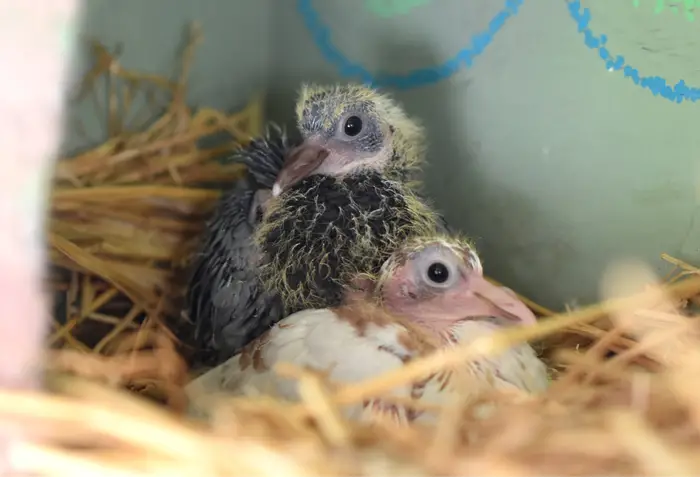
Newly hatched chicks will behave normally like other birds. Here are some typical actions.
- Rest: Newly hatched chicks will rest for several hours after hatching.
- Exploration: Chicks will explore their environment by pecking at objects and vocalizing. However, it will try to find a warm place nearby.
- Eating: Chicks will begin to eat and drink within the first 24-48 hours after hatching.
Pigeon Chick Development Stages

Three stages of chick development can be distinguished: embryonic, neonatal, and postnatal. Here is what happens in all these stages.
1. Embryonic Stage
- This stage begins when the fertilized egg is incubated and lasts until the chick hatches.
- Vital organs and systems develop, including the circulatory, respiratory, and nervous systems.
2. Neonatal stage:
- Begins at hatching and lasts for about two weeks.
- The chick adjusts to its new surroundings.
- Chick starts to move around and acquire feeding and drinking behaviors.
3. Postnatal stage:
- Starts after the neonatal stage and lasts until sexual maturity.
- Includes the development of feathers, bones, and muscles.
- This stage sees the beginning of female birds’ egg-laying and sexual maturation.
Parental Care In Chick Growth
For a lot of bird species (including pigeons), both parents help with the chick’s thermoregulation, training, and feeding. The following are the developmental aspects that parents are usually concerned with.
- Maternal feeding behavior: Many bird species have specific displays to indicate to their chicks that they are about to be fed. These displays help chicks learn to recognize their parents and associate their appearance with food.
- Thermoregulation: Chicks are unable to regulate their own body temperature, so parents use brood patches or other methods to transfer heat and ensure the chicks stay warm and protected from the environment.
Chicks Fledgling Stage
The fledgling stage is when young birds leave the nest and begin to explore their surroundings.
During the fledgling stage, chicks undergo significant changes. They typically last for several weeks after hatching. During this stage, chicks develop better abilities for flying and finding food. They also get stronger physically by developing stronger muscles and bones throughout their bodies.

Fledglings may also interact with other birds and learn important behaviors for survival. It includes avoiding predators and communicating effectively.
Challenges During the Fledgling Stage.
Here are some typical difficulties fledgling pigeon chicks encounter during this phase.
- Social hierarchies: Fledgling behavior must establish their position within social groups. Because this will help to navigate complex social interactions.
- Competition for resources: Fledglings must compete with others for food, shelter, and other resources in crowded environments.
- Avoiding predators: Fledglings must learn how to recognize and avoid danger from other animals.
- Environmental factors: Fledglings must learn to adapt to changing weather conditions, habitat changes, and other environmental factors.
- Flight development: Fledglings must develop their flight skills to move around and avoid danger.
- Finding food: Young birds must learn how to find their own food sources and identify what is safe to eat.
Pigeon Parental Care During Fledgling Stage.
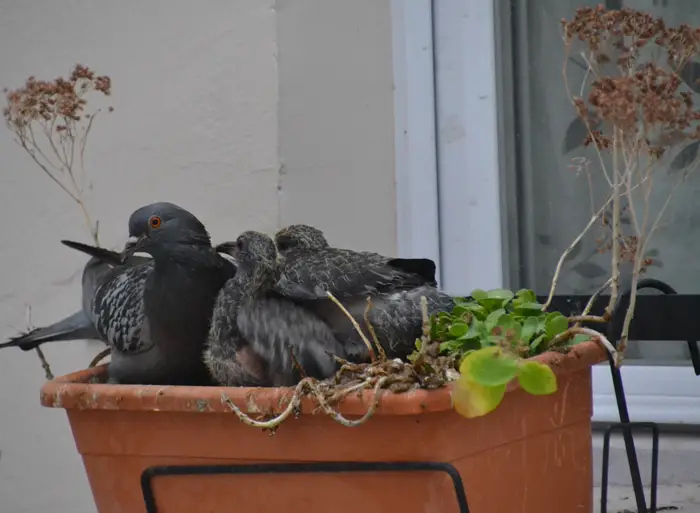
Here is how bird parental care behaviors are exhibited during the fledgling stage.
- Training: Parents play a crucial role in teaching their young important survival skills, such as foraging,
- Hunting
- Predator avoidance behaviors
- Hiding
This instruction can occur through observation, practice, or active training.
- Maternal attraction and alarm calls: Parents use vocalizations to communicate with their offspring. They attract them to food or warn them of danger.
- Feeding: Parent birds teach fledglings to feed by demonstrating how to find and catch prey. They gradually encourage them to become more independent.
Challenges Faced by Pigeon Chicks During Development

Here are the challenges pigeons face during development.
- Predation: Risk of being attacked and killed by birds of prey or cats.
- Disease: Susceptibility to various illnesses and infections that can impact health and survival.
- Habitat destruction: Loss of natural habitat due to human activities like construction and pollution.
Pigeon Conservation Efforts
Pigeon species have been facing several challenges to their survival, including habitat loss and predation
- Habitat restoration: Restoration of pigeon habitats through reforestation, wetland restoration, and other similar efforts.
- Nesting site creation: Providing artificial nesting sites, such as nesting boxes, to supplement natural nesting habitats.
- Predator management: Programs to manage and control predator populations to reduce their impact on pigeon populations.
Protecting Pigeons: Conservation and Education
Pigeon populations and their development are threatened by various factors, such as:
- Habitat destruction
- Predation
- Disease
To protect these birds, conservation efforts, including:
- Habitat restoration,
- Nesting site creation
- Predator management
These have been implemented by pigeon breeding organizations, research institutions, and conservation groups
If you’re interested in learning more about the genetic aspects of pigeons and their courtship behaviors, you may also find our articles on pigeon genetics and pigeon courtship informative. Our article on pigeon genetics explores the inheritance patterns and genetic traits that contribute to the diversity of pigeon breeds. Meanwhile, our article on pigeon courtship sheds light on the fascinating behaviors and rituals that pigeons engage in during the mating process. These articles provide valuable insights into the genetic makeup and courtship behaviors of these remarkable birds.Conclusion
In conclusion, this article “The development of pigeon chicks” has provided a comprehensive guide. It includes the development of pigeon chicks, covering important topics such as pigeon egg incubation and hatching, bird growth stages and development, the fledgling training stage, common challenges, and conservation efforts.
We have also highlighted the Artificial nesting boxes. This can help preserve pigeon populations and habitats by supporting chick development stages. For further information, we recommend reading papers such as “Growth and bird development of homing pigeons” or “Pigeon chick Intensive Care”. By implementing these strategies and continuing to study the development of pigeon chicks, we can better understand and protect these fascinating creatures.
